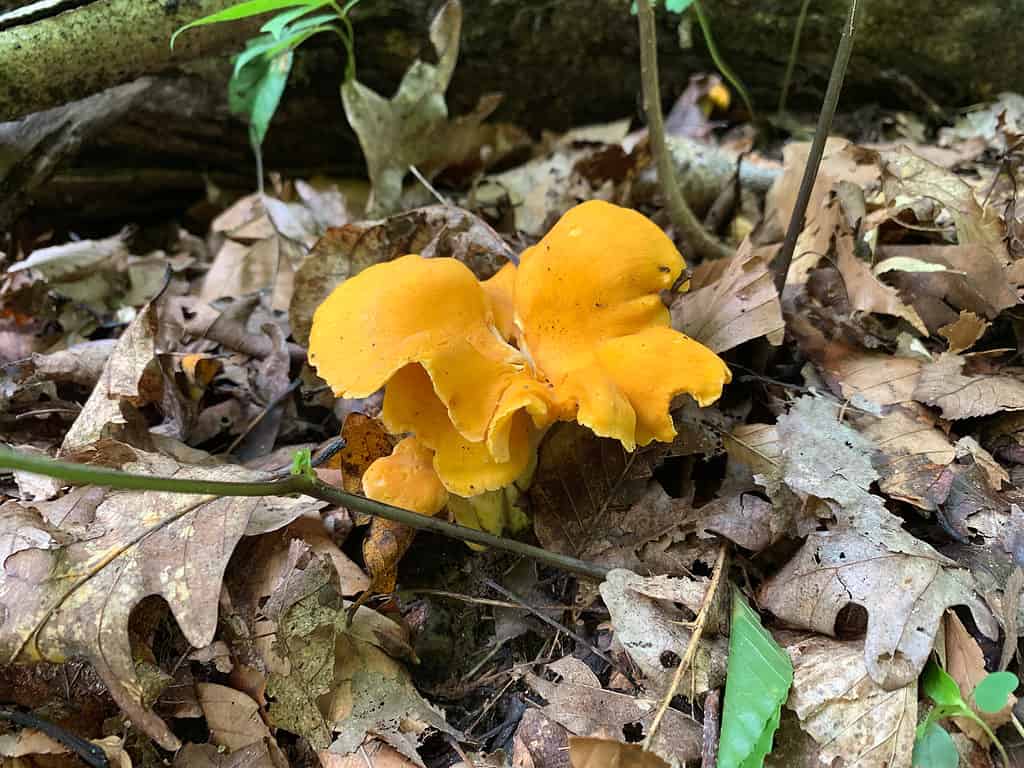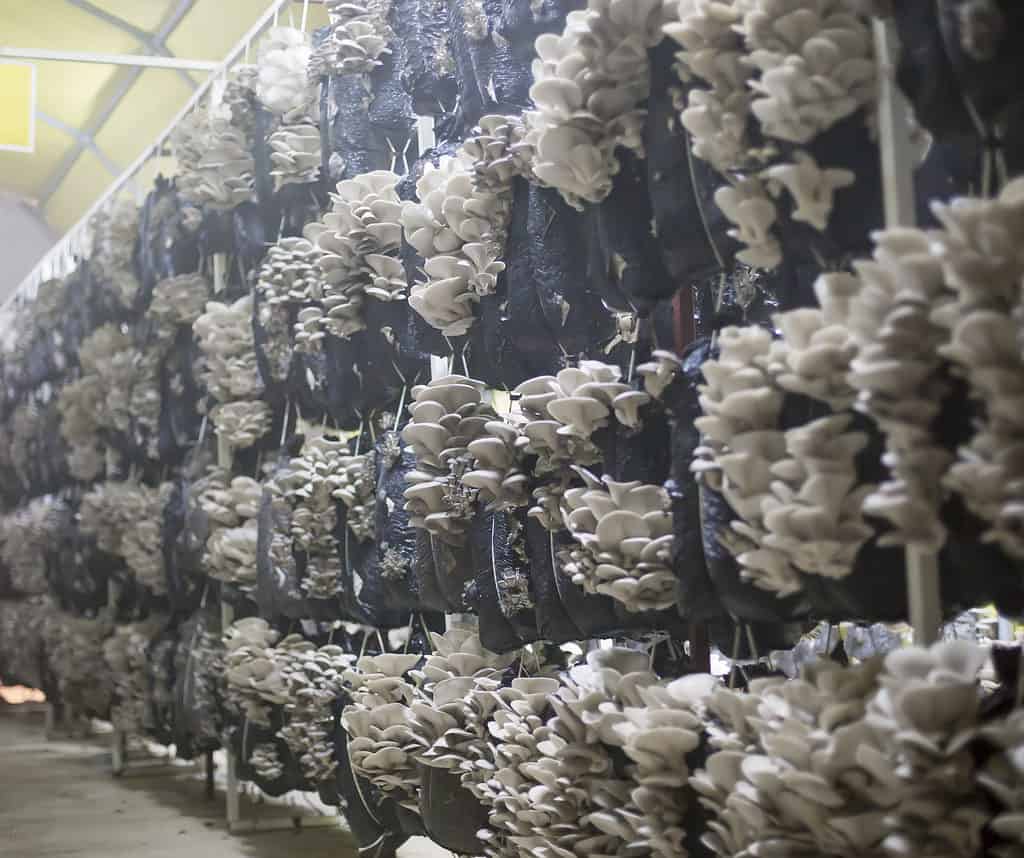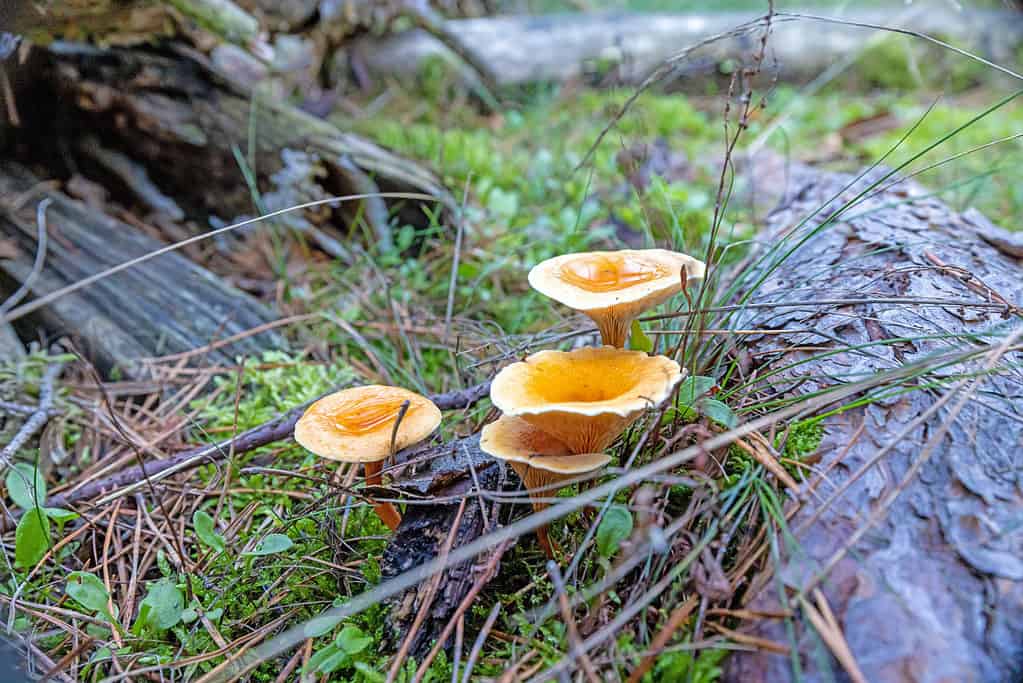Are you interested in for foraging mushrooms? If you live in Europe or North America, chanterelle mushrooms are one of the most widely-foraged wild mushrooms and appear throughout Europe and North America. Oyster mushrooms could also be a wonderful choice for a beginner foragers or amateur mushroom cultivator. They have a distinctive look and grow relatively easily. These two mushrooms are quite different from each other, but both have their own unique qualities to offer and reasons why you might want to learn how to identify them in the wild.
This article will prepare you to go into the woods and search for either a chanterelle or oyster mushroom – and to know which you may have found! By the end, you should know key characteristics of each and know some of the major differences between them. As always, be very careful when foraging for mushrooms in the woods – there are also many species you need to avoid! As you grow your mushroom knowledge, this article will be a guide for two common mushrooms you may come across or be interested in finding. Let’s explore the similarities and differences between chanterelles and oyster mushrooms now!

©Paula Savelius/Shutterstock.com
Chanterelles vs. Oyster Mushrooms
Descriptions of Chanterelles vs. Oyster Mushrooms
Chanterelles
Chanterelles are edible fungi species, most often in the Cantharellus genus in the Cantharellaceae family. Chanterelles grow across many of the world’s continents, but are particularly popular for foraging from the woods of Europe and North America. In Europe, the predominant chanterelle species is Cantharellus cibarius. In North America, there are more than 40 distinct species of chanterelles, though some of the most widespread and commonly-foraged are Cantharellus appalachiensis, Cantharellus elensis, Cantharellus fosomus, Cantharellus lateritius, and Cantharellus phasmatis. Chanterelles are an edible mushroom, which grow in the soil near trees and can be found individually or in groups.
Chanterelles have a distinctive orange or yellow color, white flesh on the inside, and a funnel-shaped cap with wavy edges. With a pleasant, delicate texture and fruity flavor and scent, chanterelles are popularly harvested for their culinary uses, though they are not widely-cultivated and must be foraged from the wild.
Oyster Mushrooms
The species Pleurotus ostreatu is commonly-known as an “oyster mushroom.” This species is one of the most popular edible mushrooms in the world, and is widely-cultivated. Oyster mushrooms gained their name for having a cap that is similar in appearance to the oysters that come from the sea. They have a distinctive, oyster-like shape and color. The mushroom caps are fan-shaped and look somewhat like an oyster shell. They typically appear in shades of white, brown, or gray. However, some varieties appear in other colors such as pink or blue.
Oyster mushrooms can be found growing on dead wood or decaying trees. They have cream-colored gills, short stems, and flat caps. These caps range in size and can be found growing to be between 2 and 10 inches across.
Oyster mushrooms appear frequently in many recipes and are grown for culinary use. Because they are very easy to grow, there is major commercial cultivation of oyster mushrooms. They are one of the most widely-consumed species in the world! They are so easily grown that it is common to find starter kits for amateur mushroom cultivators to begin growing them at home. Though there are several species in the Pleurotus genus known as “oyster mushrooms,” the most common species in North America is Pleurotus ostreatus.

©iStock.com/Igor Kramar
Key Differences
Though chanterelles and oyster mushrooms are both edible mushrooms, they have quite a few significant differences. These key differences include their colors and overall appearance, how to access to enjoy them, and their taste. Both can impart some health benefits and they are edible and popular for human consumption. However, comparing and contrasting them quickly reveals that these two are very different! Let’s explore these key differences and a few similarities together now!
Chanterelles vs. Oyster Mushrooms: History and Origins
History and Origin of Chanterelles
People have long harvested chanterelles from the woods of Europe and North America. Today, there are many restaurants and cookbooks that incorporate these rich, tender, fruity-tasting mushrooms into decadent recipes.
In Europe, the chanterelle species that grows is Cantharellus cibarius. Originally, mushroom experts believed that the chanterelle specimens identified in North America were varieties of Cantharellus cibarius. As a result, the mushrooms in North America were classified that way. However, further study revealed that Cantharellus cibarius does not actually grow on the North American continent. Rather, the chanterelles found in the United States and Canada represent more than 40 distinct species. Though many have similar appearances and flavor to the European chanterelles, they are nevertheless distinct species that can vary in appearance and have different growing needs.
Both in North America and Europe, chanterelles are commonly-foraged, in part because they are not easily cultivated. Their unique symbiotic relationship to the trees in the forests where they grow makes it challenging to commercially cultivate chanterelle species. As a result, those seeking to buy chanterelles are limited by their growing season. From summer to late autumn or early winter, you may forage in the woods for chanterelles. If that is not your vibe, try to search farmers’ markets or local groceries for chanterelles grown in the wild.

©CampSmoke/Shutterstock.com
History and Origin of Oyster Mushrooms
In contrast to chanterelles, oyster mushrooms are one of the most widely-cultivated and easy-to-grow mushroom species. Oyster mushrooms grow across Asia, continental Europe, the islands of the United Kingdom, and parts of North America. Unfortunately, there are several species that look very similar to the species Pleurotus ostreatus, leading to misidentification and some ambiguity about the true geographic distribution of oyster mushrooms in parts of the world and North America.
Oyster mushrooms first became widely-cultivated in Germany during World War I, when it rose in popularity as a subsistence food. During food shortages, people began cultivating the mushrooms to eat. In the years following, they rose in popularity as an easy-to-access, nutritious alternative to meat.
Today, oyster mushrooms are widely-cultivated in countries across the world. They are the second most-frequently cultivated mushroom after Agaricus bisporus (the species that is known as a button mushroom, crimini mushroom or baby bella mushroom, or portobello mushroom depending on its stage of maturity). They are also easily-cultivated and grow easily. Because of this, oyster mushrooms are a popular choice for beginner mycologists (people who study fungi) to learn to cultivate. If you don’t want to cultivate them yourself, you can easily find commercially-grown oyster mushrooms at your local grocery store year-round.

©iStock.com/lenoo
Chanterelles vs. Oyster Mushrooms: Appearance
Most chanterelles are considered to be small to medium-sized mushrooms. They grow to have caps that reach up to 4 inches wide and 4 inches tall. Chanterelles are funnel or cone-shaped, with wavy edges and gill-like ridges. Their distinctive orange or yellow-colored caps can be cut to reveal white or pale flesh on the inside. In the wild, you will usually find chanterelles growing in the soil at the base of trees. They most often grow near oaks or other hardwood tree species, though some species prefer pine or hemlock trees. Chanterelles grow individually or in small groupings.
In contrast, oyster mushrooms can grow to be medium-to-large in size. They can be small, more similar in size to chanterelles. However, some oyster mushrooms have caps that grow to be larger, at up to 10 inches in diameter! Unlike chanterelles, which grow in the soil, oyster mushrooms grow on wood. They are most often brown or gray in color, like a real oyster. However, some oyster mushrooms appear in a whole range of colors, including white, pink, blue, or yellow – a much larger range of colors than the yellow, white, or orange chanterelles! Additionally, you can look for the mushroom gills. While chanterelles have somewhat thick stems and only false, gill-like ridges, oyster mushrooms have cream-colored gills that follow a short stem.

©iStock.com/Paola Iamunno
Chanterelles vs. Oyster Mushrooms: Growing Conditions
Growing Conditions for Chanterelles
In both Europe and North America, chanterelle mushrooms grow in a symbiotic relationship with the trees of their forest environment. In summer or early fall, you can see chanterelles appear in the rich soil at the base of trees, especially hardwood tree species. As a mycorrhizal species, the chanterelles play a particular role in the health and well-being of these trees. The mycelium of the chanterelle aids the tree roots in accessing nutrients by effectively expanding the surface area of the root system. In return, chanterelles need nutrients from the healthy, living tree. This symbiotic relationship is mutually-beneficial for trees and mushrooms. Look out at the end of the summer for the small mushroom fruits of the chanterelle to appear in the moist, nutrient-rich soil at the base of the trees.
Unfortunately, this symbiotic relationship has proven difficult to recreate effectively. This has prevented scientists from successfully cultivating chanterelles on a wide scale. As a result, you typically find chanterelles that have been harvested directly from the woods. This means that they are usually only accessible during their fall or early-winter growing season.

©iStock.com/Pictures-and-Pixels
Growing Conditions for Oyster Mushrooms
Oyster mushrooms are very different. Oyster mushrooms grow directly on wood, and you can often find them on logs, fallen trees, or dead or decaying standing trees. While chanterelles enjoy a symbiotic relationship with the living trees in their forest environment, oyster mushrooms are a tree-rotting fungi. They are a saprophytic species, which means that they serve to break down the tissue of dead wood. They are not parasitic, in that they do not attack living tissue, but they help to clean up the forest by speeding up the decay process for dead trees and limbs.
While chanterelles usually grow near hardwood trees such as oaks, with particular species appearing near pine or hemlock trees, oyster mushrooms need to grow on deciduous hardwood trees, only occasionally appearing on conifers. Oyster mushrooms grow in groups, often in large numbers. Oyster mushrooms also tend to have a longer growing season than chanterelles. You may find them growing throughout the spring, summer, and fall. In some climates, they might even appear year-round! These mushrooms thrive in shady conditions, so don’t be afraid to look on the underside of logs or the sides of standing trees.

©iStock.com/lensblur
Chanterelles vs. Oyster Mushrooms: Scent and Taste
Chanterelles emit a distinctive, fruity aroma. Some people describe them as having a somewhat fruity flavor like that of a peach or apricot. In contrast, oyster mushrooms are sometimes described as having a “briny” or seafood-like taste. Though their name came from looking like an oyster and not tasting like one, some do describe their taste as a subtle seafood-like, earthy flavor. They also have a soft, meaty texture.
Chanterelles vs. Oyster Mushrooms: Health Benefits and Use
Chanterelles are rich in protein; vitamins A, E, C, and D; and beta-carotene, lycopene, fiber, and copper. To prepare chanterelles, after harvesting them and carefully inspecting to ensure that they are the edible chanterelle and not a poisonous lookalike, cook them thoroughly but gently. Some recipes add chanterelles to a meat, like venison, or add them to sauce or sauté. Their flavor is also complemented by treating them delicately, with only a light sauté in a pan with butter or simply adding them to a sauce that will enhance the mushroom’s texture and natural flavor. Enjoy them while they are in season, since you know that they had to be searched for and harvested from the woods just for you to enjoy them!
Oyster mushrooms are also popular for their nutritional qualities and flavor. Oyster mushrooms are a good source of fiber; zinc, potassium, iron, niacin, choline, and folate; have an estimated 3 grams of protein per cup; and offer smaller amounts of vitamin D and selenium. Some evidence also suggests that eating oyster mushrooms can help boost heart health, regulate blood sugar, and support a healthy immune system. Because oyster mushrooms have a delicate and subtle flavor, they are often added to pasta dishes, sautés, soups, and casseroles, to which they can impart their unique flavor and meat-like texture.
In Summary
As we have learned, chanterelles and oyster mushrooms are two edible mushroom species that can bring delicious and unique flavors to your kitchen. However, they are set apart from each other in several ways: their different appearances, their differences in cultivation, how they grow, when and where they grow, and how widely-available they are. Keep these things in mind when choosing your next mushroom recipe to cook, but consider foraging for both in the forest habitat where they thrive!
Up Next
- Oyster Mushrooms: A Complete Guide
- Jack-o’Lantern Mushrooms: A Complete Guide
- Chanterelle Mushrooms: A Complete Guide
The post Chanterelles vs. Oyster Mushrooms appeared first on AZ Animals.
from Animal News, Facts, Rankings, and More! - AZ Animals https://ift.tt/cZrdKnI